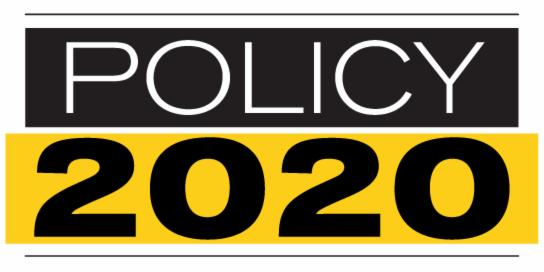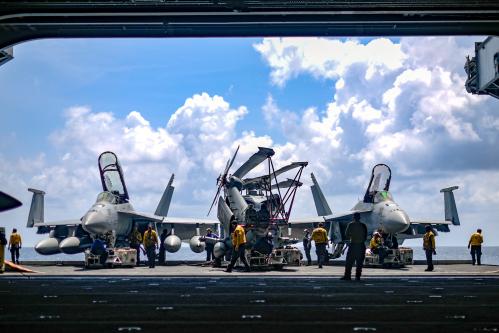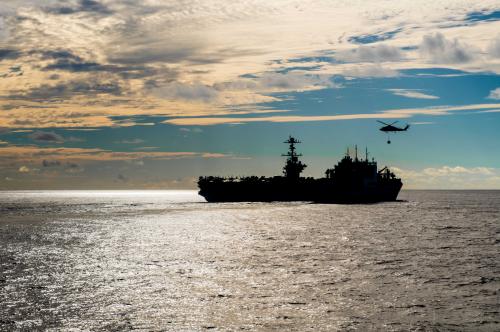The Trump administration, with the bipartisan support of Congress, has achieved large increases in defense spending in recent years. The proposed 2020 national defense budget of some $750 billion (as of this writing in November 2019, a final 2020 budget has not been passed by Congress) is much larger than the Cold War average of some $575 billion or President Obama’s last budget of just over $600 billion.
Our view is that after two decades of war, a decade of budgetary irregularities in Washington, and nearly 10 years of gradual decline in the topline, there is no doubt that the Pentagon can make good use of these funds. Former Defense Secretary Jim Mattis’ National Defense Strategy sensibly called on the Department of Defense to reinvigorate its capabilities vis-à-vis China and Russia including addressing dangerous vulnerabilities in cyberspace and outer space, while still managing today’s wars in the Middle East as well as the potential for a near-term crisis on the Korean Peninsula. That is a daunting set of tasks.
While we do not doubt that the Pentagon can make good use of a $750 billion national defense budget in 2020, we are very concerned whether it will do so. Each of the services continues to clamor for more force structure: more ships for the Navy, more tactical aircraft squadrons for the Air Force, and more troops for the Army. While growth in some key areas such as unmanned systems, cyber and space resilience, and precision-guided munitions is warranted, it makes no sense under a strategy focused on China and Russia to grow the force overall. The nation’s fiscal plight, with a 2019 federal budget deficit approaching $1 trillion, reinforces the expectation, as evidenced in the Trump administration’s own budget projections for 2021 and beyond, that real defense spending will not grow further and might well shrink. For that reason as well, tough choices are necessary.
We argue in this policy brief that the central choice for policymakers and candidates running for election in 2020 is clear. The future focus should be on quality over quantity of military capabilities. Increased military spending largely serves three objectives: better modernization for the future, upgraded unit-by-unit readiness for today, and increased force size and structure. Of these, the last is the least important to the U.S. military for the foreseeable future, and by draining away resources needed elsewhere, increasing force size is actually counter-productive.
The U.S. armed forces need to innovate and invest in breakthrough capabilities and to improve immediate readiness, but they can do so at their current overall size. Investing in modernization and readiness rather than growth, paired with more clever and efficient management of the military, can allow today’s U.S. military of roughly 1.3 million active duty troops, just over 900,000 reservists, and almost 750,000 full-time civilians to do the job. By giving up most plans for expansion, the military services can ensure that modernization and readiness get the resources they crucially require.
Background: Is U.S. defense spending high or low?
First, some broad perspective is in order. Is today’s American military spending high or low? How one answers this question sets the political and budgetary context for more detailed debates over strategy, modernization, and force structure.
The current U.S. national defense budget is certainly large by some measures. It exceeds the Cold War average for the United States of just over $500 billion as expressed in 2020 dollars. The U.S. national defense budget, which does not include budgets for the Department of Veterans Affairs and the Department of Homeland Security (but does include Department of Energy nuclear weapons expenses as well as most intelligence accounts and war costs), constitutes nearly 40 percent of global military spending. America’s allies and close friends account for another third or so of the global total, meaning that the Western alliance system wields the preponderance of global military resources even in the context of China’s rise and Russia’s revanchism.
Individual parts of the defense budget are reasonably healthy, too. Military compensation compares well with civilian jobs requiring comparable skills and experience across the bulk of military specialties. Weapons procurement budgets exceed $100 billion a year; the so-called “procurement holiday” of the 1990s and early 2000s is by now completely over.
Research and development budgets in 2019 are also robust. Funds for training are proportionate to the size of the force, akin to Reagan-era levels as well in terms of flight hours, steaming days, major ground exercises, and other core activities. The same is true of maintenance budgets. The problem with the latter accounts in recent years has been unpredictability and delay more than inadequate resources.
But at the same time, U.S. defense spending is hardly huge or unaffordable. Relative to the size of the economy, it is down to about 3.5 percent of GDP, after having reached nearly 5 percent in the late years of George W. Bush and early years of Obama. During the Cold War, it varied roughly between 5 percent and 10 percent of GDP, by way of comparison. Also, today’s U.S. military is modest in size. Its 1.3 million active-duty uniformed personnel are far fewer than the Cold War force that exceeded 2 million during its latter decades. It is also smaller than China’s and not much bigger than the Indian or North Korean militaries. In short, it is a reasonably expensive but affordable military that relies on sustaining a qualitative edge over adversaries to maintain its combat punch and to protect U.S. interests across the globe.
U.S. military spending may well be, as President Obama noted in his 2016 State of the Union address, roughly equal to the next eight highest-spending countries combined.1 But defense budgets do not always dictate combat outcomes or ensure effective deterrence. Chinese precision missiles, Russian advanced air defenses, advanced submarines, cyberattacks, anti-satellite weapons, and other such capabilities—whether operated by Beijing and Moscow or sold to other parties—can cause asymmetric, disproportionate effects.2 New technologies offer promise for America’s armed forces, but also new ways for adversaries to challenge or hurt the United States. As such, it is essential for the Department of Defense to have enough resources to pursue a qualitative military advantage over potential adversaries through a robust and well-directed modernization program.
So yes, U.S. military spending is large. Indeed, it is now roughly three times that of China’s, the world’s number-two military power—after having been nearly 10 times as great at the turn of the century. That may sound like a comfortable advantage. It is not, especially when the correct strategic goal for the United States military is not primarily to defeat China or Russia in combat but to deter China and Russia in the first place by being able to deny the objectives of any aggression and impose unacceptable costs.
As a result of military modernization and reform efforts this century, China now possesses advanced weapons systems including the DF-21 and DF-26 anti-ship ballistic missiles with homing warheads, other precision-strike options that could be used against American and allied bases in the region, quiet submarines that could approach U.S. Seventh Fleet ships undetected, and potent threats against American cyber, space, and communications systems that have previously provided the United States with unalloyed asymmetric advantages.3 Russia, for its part, is in a position to move up to several hundred thousand forces within its own borders quickly, such that they could threaten NATO members Estonia, Latvia, and Lithuania—at a time when those three Baltic nations combined have aggregate military strength of just some 30,000, and when the United States plus other NATO allies only have about 5,000 troops in the general vicinity under normal peacetime conditions.4
One might ask why the United States should shoulder so much of the burden of deterring Russia and China—shouldn’t our allies do more? While some of America’s allies have stepped up to the plate in terms of defense spending (for example South Korea at about 2.4 percent in 2018, Australia and the U.K. at 2 percent, and France at 2.3 percent of their GDP), many have not kept their military spending levels as high as they had promised, and they have not always spent their resources well. So, without a doubt, the United States must continue to press allies to spend more for their own defense. However, even if allied defense budgets rise, the reality is that there is no substitute for the skill and scale of the U.S. military. Thus, the United States must take a lead role in deterring China and Russia from coercion or aggression.
Finally, one might ask, isn’t the Department of Defense—a federal agency not even able to audit its own expenses—so wasteful that it can preserve or improve combat power with far fewer budgetary resources? While it is true that DoD is inefficient, much of the waste is marbled into muscle—difficult to excise without painstaking and patient work, lest major combat capabilities be damaged along the way. For example, the military health care enterprise is probably too large and expensive. But access to high-quality health care is a crucial military benefit that helps attract and retain such a high-quality all-volunteer force. And most proposals for health care reform would, once implemented, save at most a few billion dollars a year—important savings, yet modest relative to the overall size of the nation’s military budget and defense needs.
Or take base closures. After five generally successful rounds of base closures and realignments since the late 1980s, the DoD still has 20 percent more infrastructure than its current force posture requires. More base closures are needed—at least one if not two more rounds. A future round will likely yield eventual savings of $2 billion to $3 billion a year, like the first four rounds.5 That’s real money, but not huge money relative to a $700 billion-plus budget. Also, net savings would not accrue for half a decade. So, like many defense reforms, base closures are more a question of smart long-term planning than a near-term budgetary fix.
The Mattis agenda: “Sharpening the American military’s competitive edge” for great-power competition
There is much to like about the overall direction that former Secretary of Defense Jim Mattis had taken, and Secretary Mark Esper has since sustained, at the Pentagon. Although we have often been critics of Trump administration foreign policy, there is a clarity and cogency to longer-term defense strategy, reflected most vividly in Mattis’ National Defense Strategy of early 2018, entitled “Sharpening the American Military’s Competitive Edge.” That document prioritized great-power competition over the forever wars of the Middle East and South Asia. The shift toward focusing on China’s rise, with economic and diplomatic as well as military tools, had begun in the Obama administration, with the so-called pivot or rebalance to Asia starting in 2011. The changes intensified after Russia’s annexation of Crimea and aggression against eastern Ukraine in 2014, and the promulgation of a “third offset” modernization agenda. But Mattis brought even greater mission clarity—and more budgetary resources—to the Department of Defense. No one wants war with Russia or China. However, to prevent it, intensified efforts to shore up America’s deterrence of these two powers, especially for possible crises or conflicts in Eastern Europe and the western Pacific region, are entirely warranted.
All that said, the Mattis revolution is incomplete at best, and now it appears to be imperiled by a recent shift in political and budgetary winds. President Trump increased the U.S. national defense budget substantially in his first three years in office. But the 2020 national defense budget of $750 billion may well prove to be the peak level of the buildup. It is worth noting that former Secretary Mattis, former Joint Chiefs Chairman General Joseph Dunford, and most recently the independent congressionally-mandated National Defense Strategy Commission had all advocated ongoing real growth of at least 3 percent a year into the indefinite future. Based on Trump administration budget projections and other political realities, they seem unlikely to get their wish.
The Democratic takeover of the House of Representatives and the persistent presence of Tea Party Republicans in the Congress do not augur well for large increases in defense spending. After all, a federal budget deficit approaching $1 trillion is a national security concern, too. There is a real threat to long-term economic power and thus national security when publicly held debt approaches the size of GDP, as will likely happen in the 2020s. Given the realities of U.S. domestic politics, it is hard to believe that meaningful deficit reduction will happen without a broad sense of shared national sacrifice. Moreover, a boom-and-bust approach to defense spending results in billions being wasted through inefficiency. Stable and predictable defense budgets help U.S. taxpayers as well as America’s global credibility.
The Mattis agenda could suffer serious harm, and the nation could face growing risks, if the defense budget is slashed. Yet never-ending real (inflation-adjusted) growth, while affordable, may be neither necessary nor sensible given the rising U.S. debt. What to do?
The path ahead: Quality over quantity, modernization and readiness over force size and force structure
Fortunately, there is a lodestar that Pentagon officials can reference to guide their difficult work—consistent, we believe, with Mattis’ central priorities and with the nation’s strategic needs. Put bluntly, the military should not grow significantly in size, as all of the services currently intend. Prioritization should instead be given to longer-term innovation and modernization, as well as unit-by-unit readiness, of the current force.
So far, the one central flaw with much needed boosts in defense spending is the rapidly increasing resources that have allowed the Army, Air Force, Navy, Marine Corps, and defense agencies to have it all. The budgets of the services have not yet demonstrated the clarity and focus of Mattis’ strategic vision. Desires for a larger force have been tacked onto more crucial matters of military innovation, as well as repairs to readiness after two decades of war and one decade of bipartisan budgetary dysfunction in Washington.
The Army now wants to grow its active-duty force from some 480,000 soldiers to at least 500,000 and perhaps to 540,000. The Navy wants to increase the size of its fleet from some 285 ships to 355 (in fairness, that goal dates back to the latter Obama years). The Air Force came out with a plan in the fall of 2018 to increase its own force structure from 312 operational squadrons (of all types of aircraft combined, and including the Guard and Reserve) to 386.
To be sure, the services have good reasons to want larger forces. Our soldiers, sailors, Marines, and airmen are often fatigued and stressed from extended deployments. And we have been asking a lot of their equipment as well. The two tragic Navy ship collisions in 2017, higher accident rates in recent training exercises, personnel shortages for military specialties like pilots, and serious readiness challenges in certain categories of equipment like Marine Corps helicopters have been the results.
The solution, however, is not a larger force, but a more consistently funded, more efficiently operated, and more modern one. For all its problems, readiness is strained and not broken, and many of the fundamentals of the force are sound.
In fact, many key elements of U.S. military readiness today are often fairly good. Start with weaponry. Most equipment is in fairly good shape. For example, Army equipment on average has mission-capable rates today exceeding 90 percent, a historically high level. That said, some types of weapons, such as many aircraft, are aging fairly substantially. And maintenance schedules have been badly disrupted due to Washington’s budgetary shenanigans.
Training was also disrupted by sequestration and continuing resolutions rather than proper budgets in recent years, and by wartime demands since 2001; but it is recovering.6 The Army is again resourcing a sustainable level of training with brigade rotations to the national training centers (almost 20 such rotations a year, roughly the correct sustainable number for a total force of some 60 brigade combat teams). The Navy also is now operating at a pace adequate to put crews and ships through major training cycles every two to three years, depending on ship type. The Marine Corps is putting 12 infantry battalions through large training exercises each year, out of an overall number roughly twice that large in the whole force. And the Air Force is funding various components of its readiness programs at 80 to 98 percent of preferred resource levels.7
A third element of readiness—people—may be the most crucial of all. Today, recruiting and retention statistics are generally good, with the partial exception of recent trends in Army recruiting. Today’s all-volunteer force is generally highly educated and experienced.8 For example, typical scores of new recruits on the armed forces qualification test have improved considerably over time relative to the population at large. They are now significantly better than in the Reagan years or the immediate pre-9/11 period (two useful benchmarks for comparison). Mean time in service, a reflection of the experience of the force (albeit an imperfect gauge of overall quality), now averages about 80 months in the enlisted ranks. In other words, the typical enlisted soldier, sailor, Marine, airman, or airwoman has been in uniform more than six years. That is not quite as good as in the 1990s when averages were 85 to 90 months, but better than the 75-month period that typified the Reagan years or the lower figures of the 1970s.9 To consider one service, albeit the one least affected by the wars of this century, Navy re-enlistment rates have been about 25 percent higher over the last 15 years than during the Reagan years (and almost twice as high as during the “hollow force” years of the late 1970s); attrition rates of those leaving the service before finishing a planned tour are also at historic lows.10
To the extent that there are problems, better management and care of the force can make a big difference. Congress needs to help by providing budgets on time and predictably, avoiding the twin scourges of sequestration and continuing resolutions that deliver resources too late and haphazardly.
And the military services, with support from civilian leadership, need to do things differently too. The Army is overworked partly because it maintains deployments of several thousand soldiers in South Korea and Poland through frequent rotations of multiple units, rather than permanent stationing of individual brigades in these locations (the Mexico border deployment of late adds to the strain). The Air Force could consider similar changes in how it maintains key units in parts of the Middle East. Several fighter squadrons could, for example, be based in Persian Gulf states rather than rotated through them. The Navy still focuses too rigidly on maintaining a permanent presence in the broader Persian Gulf and western Pacific regions. More flexible and unpredictable deployments can ease strain on the force without giving adversaries any solace. The Navy can also consider crew swaps while ships remain at sea, rather than bringing crews and ships home from deployment together every six to eight months, as is now the norm.
So, growing the military falls into the “nice to have, but not essential” category. We do not oppose it, so much as argue that if something has to give, plans to increase the size of the military should be that something. Readiness should be fixed primarily by proper, timely resourcing of individual units, equipment maintenance schedules, and the like—as well as timely replacement of aging equipment.
This leads directly to the question of modernization, which is absolutely essential for today’s and tomorrow’s force. That is not because the U.S. military is obsolescent. Rather, the pace of innovation in key areas of military technology, and the way in which vulnerabilities in our existing military could be exploited by Russia or China, require it. If we fail to make the U.S. military more modern, resilient, lethal, and survivable, the perception could grow that relative American combat power is fading—or that the American military has developed systemic vulnerabilities that an enemy could exploit to produce catastrophic failure. Deterrence could weaken. War could result. And we could quite credibly even lose such a war.
The period of 2020–40 seems likely to see even more change in the technologies and the character of warfare than have recent decades. For the period 2000–20, revolutionary technological change probably occurred only in various aspects of computers and robotics. For the next two decades, those areas will remain fast-moving, and they will be joined by various breakthroughs in artificial intelligence and the use of big data. The battlefield implications in domains such as swarms of robotic systems usable as both sensors and weapons may truly come of age. In addition, progress in laser weapons, reusable rockets, hypersonic missiles, unmanned submarines, biological pathogens, and nanomaterials may wind up being made very fast. The sum total may or may not add up to a revolution, but the potential cannot be dismissed.11
The rise of China and the return of Russia supercharge the competition and raise the strategic stakes. The marriage of rapid technological progress with hegemonic change could prove especially potent. The return of great-power competition during an era of rapid progress in science and technology could reward innovators and expose vulnerabilities, much more than has been the case in the 21st century to date.
Some areas of military technology—most types of sensors, most types of major vehicles, most underlying technologies for nuclear and chemical weapons—seem unlikely to change dramatically. But perhaps a true military revolution of sorts will occur even without such developments, due to other advances in other technological domains. The key question, as always, will be how these technology trends interact synergistically with each other, and how military organizations as well as political leaders innovate to employ them on the battlefield.
Not every modernization program is equally important, of course. Some should be rethought. The U.S. tactical aircraft modernization agenda is a prime example. In fiscal year 2019, the Pentagon requested and Congress approved about $1.9 billion for additional F/A-18 aircraft—a venerable plane that would likely not survive long against either Chinese or Russian air defenses. With a defense strategy appropriately oriented toward China and Russia, it is very difficult to make the case for buying more non-stealthy “fourth-generation” aircraft like the F/A-18.
Additional questions relate to the balance between manned and unmanned systems, and between relatively short-range fighters and longer-range bombers. All told, the United States should be shifting its resource priorities away from fourth-generation and toward fifth-generation fighters, and over time away from manned to unmanned aerial vehicles, as well as to longer-range systems. During the transition period, a portfolio of capabilities including upgrades to existing aircraft (not more fourth-generation aircraft), greater innovation and deployment of new unmanned aircraft of various ranges, more long-range stealth bombers, and fewer numbers of U.S. F-35s than currently planned (and more sales to allies and partners, who are already “forward deployed”) makes more sense.
There are other programs to reassess, and perhaps scale back or delay as well, in order to make room for more survivable systems—for example reducing procurement of surface ships in favor of attack submarines and unmanned undersea vehicles for the Navy. On balance, in broad brush and in overall resource requirements, the Mattis agenda for modernization makes sense. It is important to prioritize and preserve it.
-
Footnotes
- Barack Obama, “Remarks of President Barack Obama – State of the Union Address As Delivered,” (speech, Washington, DC, January 12, 2016), https://www.whitehouse.gov/the-press-office/2016/01/12/remarks-president-barack-obama-%E2%80%93-prepared-delivery-state-union-address.
- Jennifer H. Svan, “USAFE Chief: Russian Air Defenses No. 1 Concern,” Stars and Stripes, December 11, 2015, 2. See, for example, Eric Heginbotham et al., The U.S.-China Military Scorecard (Santa Monica, CA: RAND, 2015), https://www.rand.org/content/dam/rand/pubs/research_reports/RR300/RR392/RAND_RR392.pdf; and “Annual Report to Congress:
- Military and Security Developments Involving the People’s Republic of China 2018,” (Washington, DC: Office of the Secretary of Defense, May 2018), https://media.defense.gov/2018/Aug/16/2001955282/-1/-1/1/2018-CHINA-MILITARY-POWER-REPORT.PDF.
- General Sir Richard Shirreff, War with Russia: An Urgent Warning from Senior Military Command (New York: Quercus, 2016); and David A. Shlapak and Michael Johnson, Reinforcing Deterrent on NATO’s Eastern Flank: Wargaming the Defense of the Baltics (Santa Monica, CA: RAND, 2016), https://www.rand.org/pubs/research_reports/RR1253.html.
- Statement of Robert F. Hale, Under Secretary of Defense for Financial Management and Comptroller, Brookings Institution, Washington, DC, January 7, 2013.
- For an excellent and thorough discussion of this issue, see Robert F. Hale, “Budgetary Turmoil at the Department of Defense from 2010 to 2014: A Personal and Professional Journey,” (Washington, DC: Brookings Institution, August 2015), https://www.brookings.edu/research/papers/2015/08/budget-turmoil-defense-department-hale.
- “United States Department of Defense Fiscal Year 2016 Budget Request, Overview,” (Washington, DC: Department of Defense, February 2015), pp. 3-1 through 3-15, https://comptroller.defense.gov/Budget-Materials/Budget2016/. These figures were essentially unchanged in the FY 2017 budget proposal.
- For a similar view, though one also sharing our concerns about various challenges and problems, see Mackenzie Eaglen, State of the U.S. Military: A Defense Primer (Washington, DC: American Enterprise Institute, October 2015), 22-25, https://www.aei.org/publication/state-of-the-us-military-a-defense-primer. For a paper expressing some concerns about trends in the academic aptitude of Marine Corps officers, however, see Matthew F. Cancian and Michael W. Klein, “Military Officer Quality in the All-Volunteer Force” (Washington, DC: Brookings Institution, July 2015), https://www.brookings.edu/~/media/research/files/papers/2015/07/20-military-officer-quality/military-officer-quality-in-the-all-volunteer-force.pdf.
- “Population Representation in the Military Services, 2014,” (Washington, DC: Department of Defense, 2014), https://www.cna.org/pop-rep/2014/appendixd/d_08.html.
- “Attrition and Reenlistment of First-Term Sailors,” (Alexandria, VA: Center for Naval Analyses, 2015). For more on the development of military technology over the past two decades, see Michael O’Hanlon, “A retrospective on the so-called revolution in military affairs, 2000-2020,” (Washington, DC: Brookings Institution, September 2018), https://www.brookings.edu/research/a-retrospective-on-the-so-called-revolution-in-military-affairs-2000-2020/.
- For more on likely future developments in military technology over the coming decades, see Michael O’Hanlon, “Forecasting change in military technology, 2020-2040,” (Washington, DC: Brookings Institution, September 2018), https://www.brookings.edu/research/forecasting-change-in-military-technology-2020-2040/.
The Brookings Institution is committed to quality, independence, and impact.
We are supported by a diverse array of funders. In line with our values and policies, each Brookings publication represents the sole views of its author(s).












